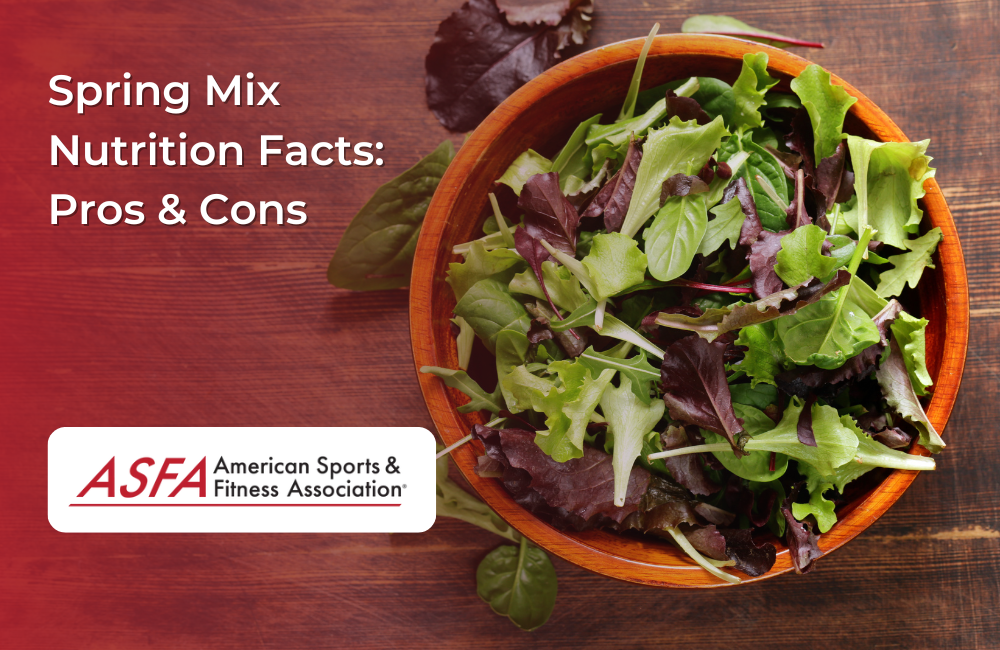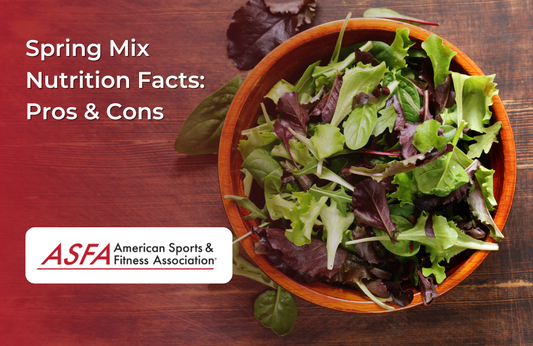Spring mix is a blend of baby lettuces, spinach, arugula, and other leafy greens, offering a variety of nutrients and flavors. It is low in calories and high in vitamins, minerals, and antioxidants, making it a healthy addition to salads and meals. However, its perishability and potential pesticide exposure should be considered.
Spring Mix Nutrition Facts: Pros, Cons, and Nutritional Profile
One cup (about 85 grams) of spring mix, composed of various green leafy vegetables such as Bok choy and kale, provides essential nutrients and health benefits. It includes:
-
Calories: Around 10
-
Carbohydrates: 2 grams
-
Fiber: 1 gram
-
Protein: 1 gram
-
Fat: 0 grams
-
Sugar: 0 grams
-
Vitamins and Minerals:
-
Vitamin A: Supports vision and immune health
-
Vitamin C: Boosts immunity and collagen production
-
Vitamin K: Essential for blood clotting and bone health
-
Folate: Supports cell growth and metabolism
-
Iron: Important for oxygen transport in the blood
-
Calcium & Magnesium: Support bone and muscle function
-
Antioxidants: Contains polyphenols, beta-carotene, and lutein, which protect against oxidative stress
What is Spring Mix?
Spring Mix is a delightful blend of various leafy green vegetables, typically including a mix of lettuce, spinach, arugula, and other greens. This popular choice for salads is often used as a base for healthy salads, offering a convenient way to incorporate a variety of leafy greens into your diet. Not only does Spring Mix provide a range of health benefits, but it also brings a medley of flavors and textures to your salad bowl. Whether you’re aiming to boost your intake of leafy green vegetables or simply enjoy a fresh, vibrant salad, Spring Mix is an excellent choice.
Key Ingredients in Spring Mix
The key ingredients in Spring Mix can vary depending on the specific blend, but common ingredients include:
-
Lettuce: Varieties such as romaine, iceberg, and butter lettuce add a crisp texture and mild flavor.
-
Spinach: This popular leafy green vegetable is rich in vitamins and minerals, contributing to the mix’s nutritional value.
-
Arugula: Known for its peppery taste, arugula adds a unique flavor and is packed with antioxidants.
-
Other Leafy Greens: Kale, collard greens, and mustard greens are often included, each bringing their own health benefits and distinct tastes.
-
Herbs: Fresh herbs like parsley or basil can be added for an extra burst of flavor and additional nutrients.
By combining these diverse ingredients, Spring Mix offers a well-rounded and nutrient-dense option for your salads.
Fiber Content of Spring Mix
Spring Mix is a good source of dietary fiber, with a 1-cup serving providing around 2-3 grams of fiber. The fiber content can vary depending on the specific ingredients and their proportions in the mix. Dietary fiber is essential for maintaining healthy digestion and supporting gut health. It helps promote bowel regularity, prevent constipation, and can even aid in weight management by promoting a feeling of fullness. Including Spring Mix in your diet is an easy and delicious way to boost your fiber intake and enjoy the many health benefits that come with it.
Pros of Eating Leafy Greens
Low in Calories and Supports Weight Management
-
Only 10 calories per serving, making it an excellent base for nutrient-dense meals. Raw spinach, a common ingredient in spring mix, is low in calories and rich in essential vitamins.
-
High fiber content promotes satiety and helps control appetite.
Rich in Antioxidants and Anti-Inflammatory Compounds
-
Contains polyphenols, beta-carotene, and vitamin C, which help protect cells from oxidative damage.
-
May help reduce inflammation and support overall health.
High in Vitamins and Minerals
-
Vitamin A and C help strengthen the immune system and promote skin health.
-
Iron and folate support energy production and red blood cell formation.
-
Red leaf lettuce, often included in spring mix, is rich in vitamins A and K, contributing to the mix's overall nutritional value.
Supports Heart Health
-
Low in sodium and high in potassium, which helps regulate blood pressure.
-
Fiber and antioxidants may help reduce cholesterol levels.
Aids Digestion and Gut Health
-
High fiber content promotes digestion and supports gut bacteria.
-
Helps prevent constipation and supports bowel regularity.
Versatile and Easy to Use
-
Can be eaten raw in salads, blended in smoothies, or sautéed in dishes.
-
Works well with various dressings, proteins, and toppings.
-
Romaine lettuce, a common ingredient in spring mix, is known for its sturdy leaves and nutritional benefits, making it a versatile choice for various dishes.
Cons of Eating Spring Mix
Can Be Prone to Contamination
-
Pre-packaged salad mixes have been linked to bacterial contamination (E. coli, Salmonella).
-
Washing even "pre-washed" greens reduces contamination risk.
Perishable and Spoils Quickly
-
Short shelf life, requiring refrigeration and quick consumption.
-
Wilts or becomes slimy if not stored properly.
May Contain Pesticide Residues
-
Non-organic spring mixes may have pesticide residues from farming practices.
-
Choosing organic or washing greens thoroughly helps reduce exposure.
Contains Oxalates (May Affect Mineral Absorption)
-
Some leafy greens, like spinach, contain oxalates, which can bind to calcium and iron, reducing absorption.
-
Rotating different types of salad greens in your diet can help balance oxalate intake.
Tips for Choosing a Healthy Spring Mix
When choosing a Spring Mix, consider the following tips to ensure you’re getting the freshest and most nutritious option:
-
Freshness: Look for a mix with fresh, crisp leaves and no signs of wilting or browning. Fresh greens not only taste better but also retain more nutrients.
-
Variety: Opt for a mix that includes a variety of leafy greens to ensure a range of nutrients and flavors. A diverse mix can provide a broader spectrum of vitamins and minerals.
-
Low Sodium: Check the nutrition label to ensure the mix is low in sodium. While leafy greens are naturally low in sodium, some pre-packaged mixes may contain added salt.
-
No Added Preservatives: Choose a mix that is free from added preservatives and artificial ingredients. Fresh, natural greens are always the best choice for a healthy diet.
By following these tips, you can enjoy the full health benefits of Spring Mix and make the most of this versatile and nutritious salad green.
Conclusion
Spring mix is a low-calorie, nutrient-dense leafy green blend that provides essential vitamins, antioxidants, and fiber. It supports heart health, digestion, and immune function while being a versatile addition to meals. However, its short shelf life, potential for contamination, and pesticide exposure should be considered. Choosing organic options and proper storage helps maximize its benefits.
FAQs
Is spring mix good for weight loss?
Yes, it is low in calories and high in fiber, making it a great option for weight management.
Should I wash pre-packaged spring mix?
Yes, even "triple-washed" greens may contain bacteria, so washing them before eating is recommended.
Can I eat spring mix every day?
Yes, but rotating greens (such as kale, romaine, and arugula) helps provide a variety of nutrients and reduces oxalate intake.
Does spring mix contain protein?
It contains a small amount of protein, but it is not a significant source.
How do I keep spring mix fresh longer?
Store it in a sealed container with a paper towel to absorb excess moisture and prevent wilting.
Is spring mix better than iceberg lettuce?
Yes, spring mix is higher in fiber, vitamins, and antioxidants compared to iceberg lettuce.
Can I cook spring mix?
Yes, it can be lightly sautéed, added to soups, or blended into smoothies.
Is organic spring mix better?
Organic options reduce pesticide exposure, but both organic and conventional spring mix provide similar nutrients.





